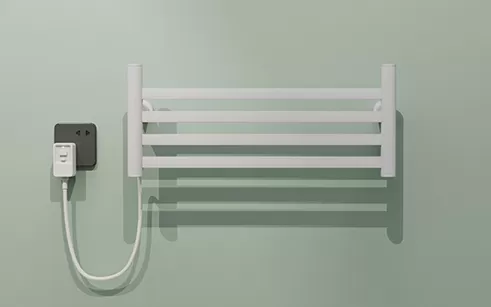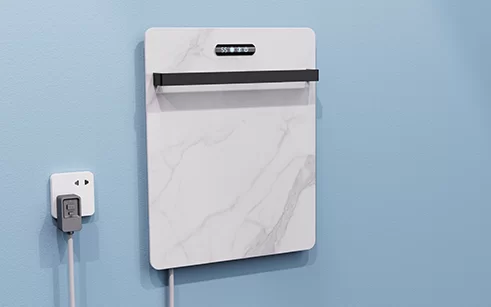
Heated towel rails have become a luxurious and practical addition to modern bathrooms. However, many homeowners wonder, Do heated towel rails use a lot of power?
This blog will explore the energy efficiency of heated towel rails, how much electricity they use, and offer tips for maximizing energy savings.
Heated towel rails not only keep your towels dry and warm but also enhance bathroom comfort. Their benefits include:
| Benefit | Description |
| Comfort | Enjoy a warm, cozy towel every time you step out of the shower. |
| Hygiene | Prevent mold and mildew growth by drying towels more efficiently. |
| Energy Efficiency | Electric towel warmers can heat your bathroom while providing space-saving benefits. |
Comfort: Enjoy a warm, cozy towel every time you step out of the shower.
Hygiene: Heated rails help prevent mold and mildew growth by drying towels more efficiently.
Energy Efficiency: Some models, especially electric towel warmers, can heat your bathroom while also providing space-saving benefits.
Generally, electric towel warmers are designed to be energy-efficient. A typical electric towel warmer consumes around 60 to 100 watts of power per hour, which is relatively low compared to other household appliances.
[caption id="attachment_816" align="alignnone" width="491"] XN WH307 Towel Electric Heater[/caption]
XN WH307 Towel Electric Heater[/caption]
The amount of electricity a towel warmer uses depends on factors such as its wattage and how long it is operated. To estimate how much electricity it consumes, you can use the formula:
Electricity consumption = Power (watts) x Time (hours) / 1000
For instance, if a towel warmer has a power rating of 80 watts and runs for 2 hours, the electricity usage would be:
80 watts x 2 hours = 160 watt-hours (0.16 kWh)
On average, running a towel warmer for 1 hour uses only a few cents of electricity, making them a cost-effective luxury for many households.
When choosing a heated towel rail, several factors can influence its energy efficiency.
| Factor | Description |
| Material Selection | Stainless steel and chrome models heat up quickly and retain heat better, enhancing energy efficiency. |
| Size Selection | Larger towel rails require more energy to heat, while smaller models are generally more energy-efficient. |
| Shape and Design | Designs that allow better airflow or are more compact tend to use less energy. |
| Rod and Fin Design | More rods and fins increase surface area for heat distribution, improving efficiency but may require more energy. |
The material of the towel rail affects its heat retention. Stainless steel and chrome models tend to heat up quickly and retain heat better than other materials, making them more energy-efficient.
A larger towel rail will generally require more energy to heat, whereas a smaller model will use less. Consider your space and needs when selecting a size that balances efficiency and practicality.
The design and shape of the towel warmer can impact its energy efficiency. Models that allow for better airflow or feature a more compact design will generally perform better in terms of energy consumption.
The more rods and fins a towel warmer has, the greater the surface area for heat distribution. This can lead to more efficient heat transfer, but it may also require more energy. It’s important to choose a design that suits your heating needs without excess energy consumption.
While heated towel rails are energy-efficient, there are several ways you can reduce their running costs even further.
| Energy-Saving Tip | Description |
| Use a Timer | Set a timer to ensure the towel rail operates only when needed, reducing unnecessary power consumption. |
| Choose Thermostatically Controlled Models | These models automatically adjust temperature, preventing overheating and energy waste. |
| Opt for Lower Wattage Models | Lower-wattage towel warmers consume less energy while still providing effective performance. |
| Use Only When Needed | Turn the towel warmer on just before use and off afterward to avoid unnecessary energy consumption. |
One of the easiest ways to save energy is by setting a timer for your heated towel rail. This ensures it operates only when needed, reducing unnecessary power consumption.
Thermostatic models adjust the temperature automatically, preventing the towel rail from overheating and wasting energy. These models help maintain a consistent temperature without using excess power.
While higher-wattage towel warmers provide faster heating, they also consume more energy. Choosing a lower-wattage model can be a great way to reduce electricity usage without compromising on performance.
To maximize savings, use your towel warmer only when necessary. For example, turn it on just before showering or bathing and turn it off after use. This will ensure you’re not consuming power unnecessarily.
Looking for the best energy-efficient electric towel warmers? Consider models that feature low power consumption, thermostatic controls, and smart design features. Brands offering high-quality electric towel warmers like FAAO are known for their energy-efficient systems that balance performance and power usage.
The Electric Towel Warmers are designed to offer both luxury and functionality, providing an efficient solution to keep towels warm and dry. Available in a variety of designs, including Aluminum Alloy, Tempered Glass, and Sintered Stone, these towel warmers are built for durability and style, seamlessly complementing any bathroom decor.
With over 25 years of experience in bathroom production, the FAAO factory spans 20,000 square meters and employs over 300 skilled workers. The company has successfully exported high-quality electric towel warmers to more than 80 countries worldwide and collaborates with top suppliers, including several Fortune 500 companies. Additionally, OEM/ODM services are offered in partnership with major DIY retailers and multinational distributors, delivering innovative products to millions of households globally.
So, do heated towel rails use a lot of power? Not necessarily. When used properly, electric towel warmers are an affordable and energy-efficient option to keep your towels warm and dry. By selecting the right model, using timers, and taking simple energy-saving steps, you can enjoy the luxury of a heated towel rail without worrying about high electricity costs.
Choosing the best energy-efficient electric towel warmer system will not only ensure that your towel rail uses minimal energy but also add a touch of comfort and elegance to your bathroom.
Do Heated Towel Rails Use a Lot of Electricity?